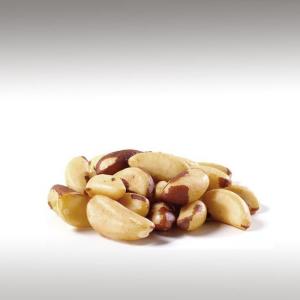
BRAZIL NUT OIL (BERTHOLLETIA EXCELSA) - BASE OILS

BASE / GENERAL DATA
Information submited: February 1, 2015 Modified: April 3, 2018 By: OperaDreamhouse
The Brazil Nut tree is the only species in the monotypic genus Bertholletia. It is native to the Guianas, Venezuela, Brazil, eastern Colombia, eastern Peru, and eastern Bolivia. The Brazil Nut is a large tree, reaching 50 m tall and with a trunk 1 to 2 in diameter, making it among the largest of trees in the Amazon rainforests. It may live for 500 years or more, and according to some authorities often reaches an age of 1,000 years.
In Brazil, it is illegal to cut down a Brazil Nut tree. As a result, they can be found outside production areas, in the backyards of homes and near roads and streets. The fruit containing nuts is very heavy and rigid, and it poses a serious threat to vehicles and persons passing under the tree.
The fruit takes 14 months to mature after pollination of the flowers. The fruit itself is a large capsule 10 - 15 cm in diameter, resembling a coconut endocarp in size and weighing up to 2 kg. It has a hard, woody shell 8 - 12 mm thick, which contains eight to 24 triangular seeds 4 - 5 cm long (the "Brazil Nuts") packed like the segments of an Orange. Around 20,000 tons of Brazil Nuts are harvested each year, of which Bolivia accounts for about 50%, Brazil 40%, and Peru 10%.
Chemical structure:
Brazil Nut oil contains 75% unsaturated fatty acids composed mainly of oleic and linolenic acids, as well as the phytosterol, beta-sitosterol, and fat-soluble Vitamin E. Brazil Nut oil is also rich in magnesium and has the highest known concentration of selenium of any nut oil.
Palmitic acid 16 - 20%
Palmitoleic acid 0,5 - 1,2%
Stearic acid 9 - 13%
Oleic acid 36 - 45%
Linoleic acid 33 - 38%
Saturated fats 25%
Unsaturated fats 75%
Brazil Nut oil is clear yellowish oil with a pleasant, sweet smell and taste. The three sided Brazil Nut with meat of flesh that consists of 70% fat or oil and 17% protein.
In Brazil, it is illegal to cut down a Brazil Nut tree. As a result, they can be found outside production areas, in the backyards of homes and near roads and streets. The fruit containing nuts is very heavy and rigid, and it poses a serious threat to vehicles and persons passing under the tree.
The fruit takes 14 months to mature after pollination of the flowers. The fruit itself is a large capsule 10 - 15 cm in diameter, resembling a coconut endocarp in size and weighing up to 2 kg. It has a hard, woody shell 8 - 12 mm thick, which contains eight to 24 triangular seeds 4 - 5 cm long (the "Brazil Nuts") packed like the segments of an Orange. Around 20,000 tons of Brazil Nuts are harvested each year, of which Bolivia accounts for about 50%, Brazil 40%, and Peru 10%.
Chemical structure:
Brazil Nut oil contains 75% unsaturated fatty acids composed mainly of oleic and linolenic acids, as well as the phytosterol, beta-sitosterol, and fat-soluble Vitamin E. Brazil Nut oil is also rich in magnesium and has the highest known concentration of selenium of any nut oil.
Palmitic acid 16 - 20%
Palmitoleic acid 0,5 - 1,2%
Stearic acid 9 - 13%
Oleic acid 36 - 45%
Linoleic acid 33 - 38%
Saturated fats 25%
Unsaturated fats 75%
Brazil Nut oil is clear yellowish oil with a pleasant, sweet smell and taste. The three sided Brazil Nut with meat of flesh that consists of 70% fat or oil and 17% protein.

SPIRITUAL PRACTISES DATA

MEDICINE / HEALTH DATA

BEAUTY / COSMETICS DATA

FOOD / COOKING DATA
COMMENTS
No comments.


